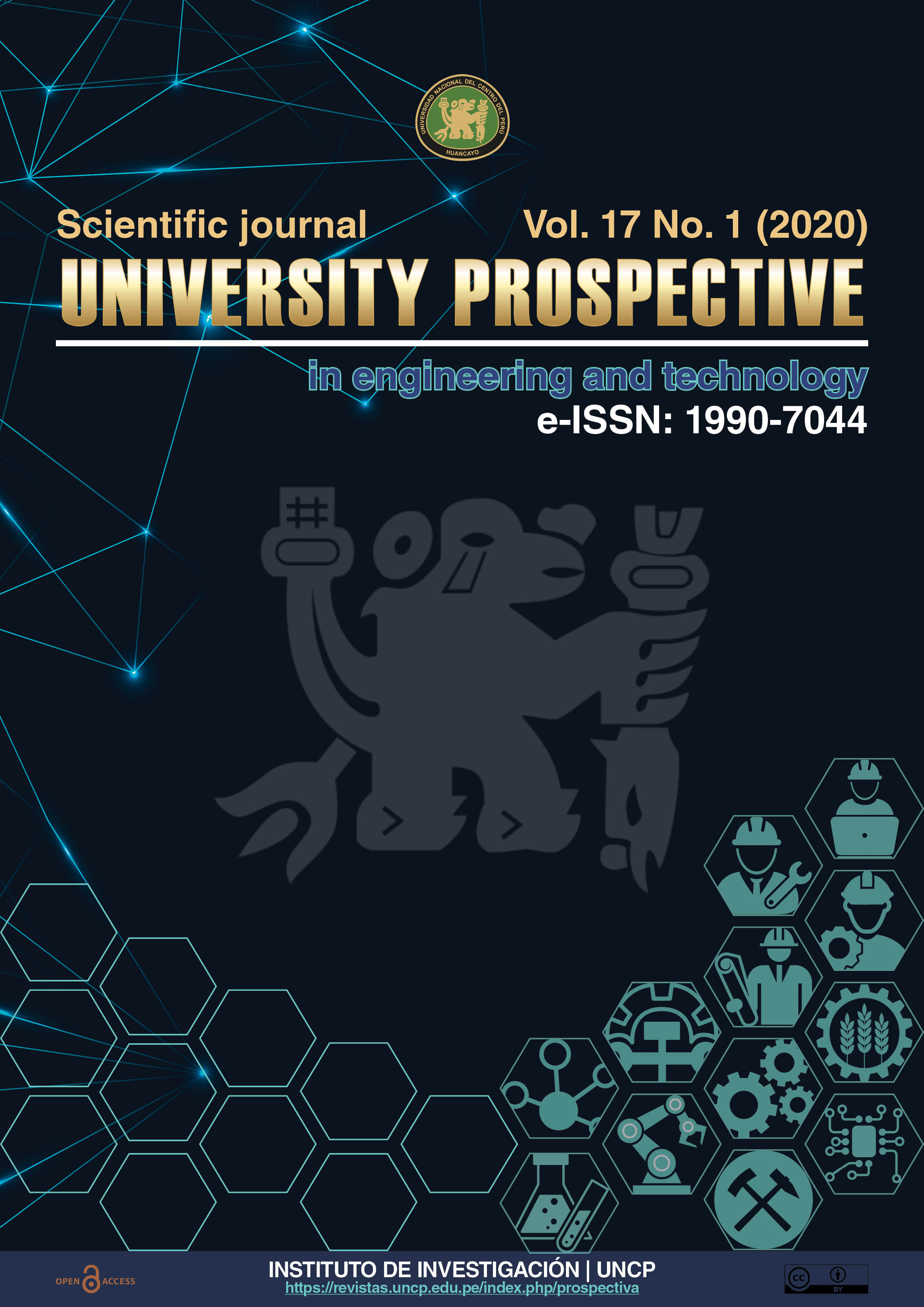Acid pretreatment of Celery waste (Apium Graveolens)
DOI:
https://doi.org/10.26490/uncp.prospectivauniversitaria.2020.17.1396Keywords:
Celery residues, Acid pretreatment, CelluloseAbstract
The research determined the influence of time, temperature and H2SO4 dose on the characteristics of cellulose and glucose concentration in the acid pretreatment of celery residues, in such a way that the pretreated celery residues have the best conditions for the hydrolysis and subsequent fermentation, and having ethanol as the final product. The experimental part consisted of collecting and preparing the celery residues, preparing the DNS reagent and elaborating the glucose calibration curve that is used to determine the concentration of reducing sugars, carrying out the acid pretreatment to 25 g of residues in each experiment and determining cellulose morphology with the Mira 3 Tescan scanning electron microscope (SEM). The variables that were evaluated are the concentration of H2SO4 (0.1%, 2.5% and 4.0%), temperature (60, 70 and 80 °C) and time (2, 3 and 4 hours) and the experiments of the experimental design were followed. From the initial tests, the low levels of the variables are the best conditions of the acid pretreatment due to the morphology they present that agree with what is indicated in the literature, with this the production of glucose in hydrolysis will be higher and ethanol in fermentation
Downloads
References
Cekmecelioglu D, Uncu ON. Kinetic modeling of enzymatic hydrolysis of pretreated kitchen wastes for enhancing bioethanol production. Waste Manag [Internet]. 2013;33(3):735–9. Available from: http://dx.doi.org/10.1016/j.wasman.2012.08.003
Vavouraki AI, Volioti V, Kornaros ME. Optimization of thermo-chemical pretreatment and enzymatic hydrolysis of kitchen wastes. Waste Manag [Internet]. 2014;34(1):167–73. Available from: http://dx.doi.org/10.1016/j.wasman.2013.09.027
Uncu ON, Cekmecelioglu D. Cost-effective approach to ethanol production and optimization by response surface methodology. Waste Manag [Internet]. 2011;31(4):636–43. Available from: http://dx.doi.org/10.1016/j.wasman.2010.12.007
Ntaikou I, Menis N, Alexandropoulou M, Antonopoulou G, Lyberatos G. Valorization of kitchen biowaste for ethanol production via simultaneous saccharification and fermentation using co-cultures of the yeasts Saccharomyces cerevisiae and Pichia stipitis. Bioresour Technol [Internet]. 2018;263:75–83. Available from: https://doi.org/10.1016/j.biortech.2018.04.109
Negi H, Agrawal R, Verma A, Goel R. Municipal solid waste to bioenergy: Current status, opportunities, and challenges in Indian context [Internet]. New and Future Developments in Microbial Biotechnology and Bioengineering. Elsevier B.V.; 2019. 191–203 p. Available from: http://dx.doi.org/10.1016/B978-0-444-64191-5.00014-6
Zabot GL, Tres M V., Ferreira PAA, Dal Molin A, Mazutti MA. Power the future with bioenergy from organic wastes. In: Recent Developments in Bioenergy Research [Internet]. BV; 2020. p. 85–114. Available from: http://dx.doi.org/10.1016/B978-0-12-819597-0.00004-0
Trivedi J, Bhonsle AK, Atray N. Processing food waste for the production of platform chemicals [Internet]. Refining Biomass Residues for Sustainable Energy and Bioproducts. Elsevier Inc.; 2020. 427–448 p. Available from: http://dx.doi.org/10.1016/B978-0-12-818996-2.00019-3
Demesa AG, Laari A, Sillanpää M. Value-added chemicals and materials from lignocellulosic biomass [Internet]. Advanced Water Treatment. Elsevier Inc.; 2020. 367–436 p. Available from: http://dx.doi.org/10.1016/B978-0-12-819225-2.00006-5
Hendriks ATWM, Zeeman G. Pretreatments to enhance the digestibility of lignocellulosic biomass. Bioresour Technol. 2009;100(1):10–8.
Otles S, Kartal C. Food waste valorization [Internet]. Sustainable Food Systems from Agriculture to Industry. Elsevier Inc.; 2018. 371–399 p. Available from: http://dx.doi.org/10.1016/B978-0-12-811935-8.00011-1
Speight JG. Hydrocarbons from biomass. Handbook of Industrial Hydrocarbon Processes. 2020. 293–342 p.
Verardi A, Lopresto CG, Blasi A, Chakraborty S, Calabrò V. Bioconversion of lignocellulosic biomass to bioethanol and biobutanol [Internet]. Lignocellulosic Biomass to Liquid Biofuels. INC; 2020. 67–125 p. Available from: http://dx.doi.org/10.1016/B978-0-12-815936-1.00003-4
Bajpai P. Biomass conversion processes. Biomass to Energy Conversion Technologies. 2020. 41–151 p.
Dey P, Pal P, Kevin JDi, Das DiB. Lignocellulosic bioethanol production: Prospects of emerging membrane technologies to improve the process - A critical review. Rev Chem Eng. 2018;
Chiaramonti D, Giovannini A, Janssen R, Mergner R. Lignocellulosic ethanol production plant by Biochemtex in Italy Lignocellulosic Ethanol Process and Demonstration A Handbook Part I [Internet]. 2013. 140 p. Available from: www.wip-munich.de
Ranjithkumar M, Ravikumar R, Sankar MK, Kumar MN, Thanabal V. An effective conversion of cotton waste biomass to ethanol: A critical review on pretreatment processes. Waste and Biomass Valorization. 2017;8(1):57–68.
Núñez RÁ, Pérez BR, Hernández R, Nacional U, Francisco E, Perozos NAL. Contenido de azúcares totales, reductores y no reductores en Agave cocui Trelease. Multiciencias. 2012;12(2):129–35.
Sarabandi K, Gharehbeglou P, Jafari SM. Scanning electron microscopy (SEM) of nanoencapsulated food ingredients [Internet]. Characterization of Nanoencapsulated Food Ingredients. Elsevier Inc.; 2020. 83–130 p. Available from: http://dx.doi.org/10.1016/B978-0-12-815667-4.00003-1
Vladár AE, Hodoroaba VD. Characterization of nanoparticles by scanning electron microscopy [Internet]. Characterization of Nanoparticles: Measurement Processes for Nanoparticles. Elsevier Inc.; 2019. 7–27 p. Available from: http://dx.doi.org/10.1016/B978-0-12-814182-3.00002-X
Downloads
Published
Issue
Section
License
Copyright (c) 2020 Eufracio Arias, Wilder E.

This work is licensed under a Creative Commons Attribution-NonCommercial-ShareAlike 4.0 International License.
Esta Revista es de acceso abierto a su contenido a través del Internet, poniendo a disposición de la comunidad científica los resultados de la investigación, de manera gratuita, para el intercambio del conocimiento desarrollado.
El contenidos de la Revista se distribuyen bajo la licencia Creative Commons Reconocimiento-NoComercial-CompartirIgual 4.0 Internacional.
![IconJournalPU [ENG] by Edgar Julian-Laime®](https://revistas.uncp.edu.pe/public/journals/1/pageHeaderLogoImage_en.png)









